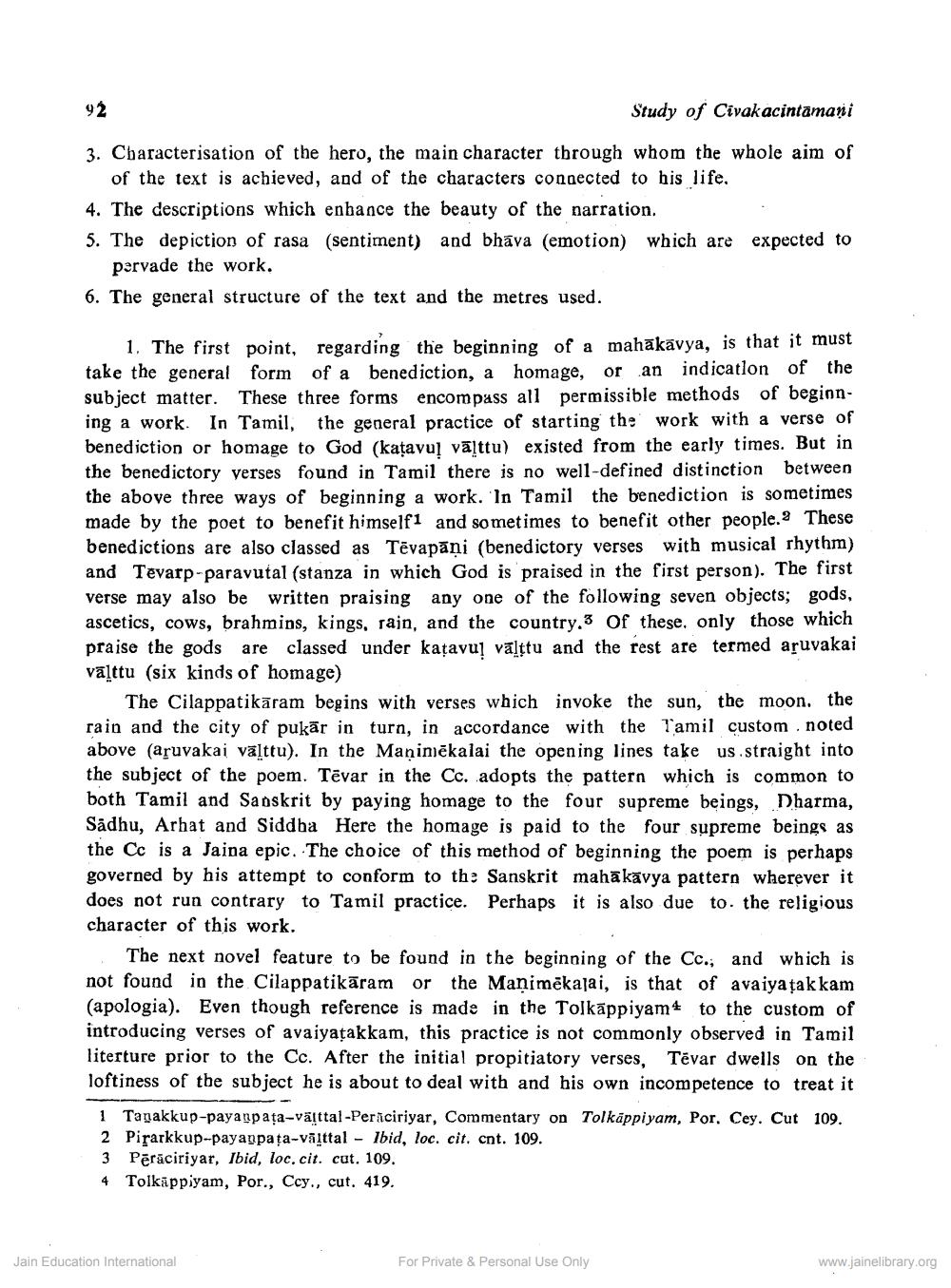________________
Study of Civakacintamani
3. Characterisation of the hero, the main character through whom the whole aim of
of the text is achieved, and of the characters congected to his life. 4. The descriptions which enbance the beauty of the narration. 5. The depiction of rasa (sentiment) and bhava (emotion) which are expected to
parvade the work. 6. The general structure of the text and the metres used.
1. The first point, regarding the beginning of a mahakāvya, is that it must take the general form of a benediction, a homage, or an indication of the subject matter. These three forms encompass all permissible methods of beginning a work. In Tamil, the general practice of starting the work with a verse of benediction or homage to God (katavul välttu) existed from the early times. But in the benedictory verses found in Tamil there is no well-defined distinction between the above three ways of beginning a work. In Tamil the benediction is sometimes made by the poet to benefit himself and sometimes to benefit other people. These benedictions are also classed as Tēvapāni (benedictory verses with musical rhythm) and Tevarp-paravutal (stanza in which God is praised in the first person). The first verse may also be written praising any one of the following seven objects; gods, ascetics, cows, brahmins, kings, rajn, and the country.3 of these, only those which praise the gods are classed under kațavuị vālţtu and the rest are termed asuvakai valttu (six kinds of homage)
The Cilappatikāram begins with verses which invoke the sun, the moon. the rain and the city of pukār in turn, in accordance with the Tamil custom . noted above (aruvakai välttu). In the Maninjēkalai the opening lines take us straight into the subject of the poem. Tēvar in the Cc. adopts the pattern which is common to both Tamil and Sanskrit by paying homage to the four supreme beings, Dharma, Sadhu, Arhat and Siddha Here the homage is paid to the four supreme beings as the Cc is a Jaina epic. The choice of this method of beginning the poem is perhaps governed by his attempt to conform to the Sanskrit mahākavya pattern wherever it does not run contrary to Tamil practice. Perhaps it is also due to the religious character of this work.
The next novel feature to be found in the beginning of the Cc.; and which is not found in the Cilappatikāram or the Manimēkajai, is that of avaiyațakkam (apologia). Even though reference is made in the Tolkāppiyam to the custom of introducing verses of avaiyațakkam, this practice is not commonly observed in Tamil literture prior to the Cc. After the initial propitiatory verses, Tévar dwells on the loftiness of the subject he is about to deal with and his own incompetence to treat it 1 Tanakkup-payanpața-västtal-Periciriyar, Commentary on Tolkāppiyam, Por, Cey. Cut 109. 2 Pirarkkup-payagpata-vālttal - Ibid, loc. cit. cnt. 109. 3 Pērāciriyar, Ibid, loc. cit. cut. 109. 4 Tolkāppiyam, Por., Ccy., cut. 419.
Jain Education International
For Private & Personal Use Only
www.jainelibrary.org




